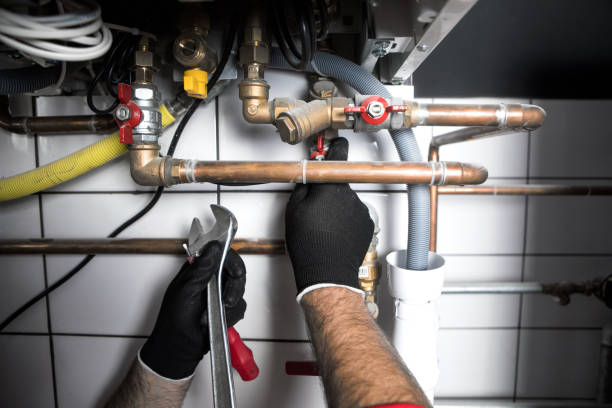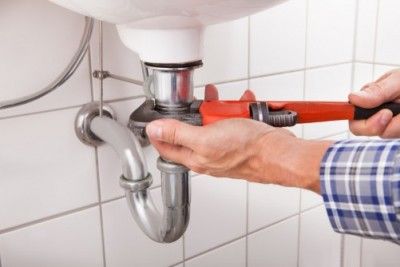How to Understand Your Home's Plumbing System Anatomy
How to Understand Your Home's Plumbing System Anatomy
Blog Article
Any individual maintains his or her own thinking about Plumbing Installation 101: All You Need to Know.

Comprehending exactly how your home's pipes system functions is crucial for every single home owner. From supplying tidy water for alcohol consumption, food preparation, and showering to securely eliminating wastewater, a well-kept plumbing system is important for your household's wellness and convenience. In this detailed guide, we'll explore the intricate network that makes up your home's pipes and deal pointers on upkeep, upgrades, and dealing with common issues.
Intro
Your home's pipes system is greater than just a network of pipes; it's an intricate system that guarantees you have access to clean water and reliable wastewater elimination. Knowing its components and just how they interact can assist you avoid expensive repair work and ensure every little thing runs efficiently.
Basic Elements of a Pipes System
Pipes and Tubing
At the heart of your pipes system are the pipes and tubes that bring water throughout your home. These can be made of numerous products such as copper, PVC, or PEX, each with its advantages in regards to toughness and cost-effectiveness.
Fixtures: Sinks, Toilets, Showers, and so on.
Fixtures like sinks, toilets, showers, and bathtubs are where water is utilized in your home. Recognizing exactly how these components link to the plumbing system aids in identifying troubles and preparing upgrades.
Shutoffs and Shut-off Points
Shutoffs manage the circulation of water in your pipes system. Shut-off valves are critical during emergencies or when you need to make repair work, allowing you to separate parts of the system without interfering with water circulation to the whole home.
Water Supply System
Key Water Line
The main water line links your home to the municipal supply of water or a personal well. It's where water enters your home and is dispersed to numerous fixtures.
Water Meter and Pressure Regulatory Authority
The water meter measures your water use, while a pressure regulator makes sure that water moves at a safe stress throughout your home's pipes system, avoiding damage to pipes and fixtures.
Cold Water vs. Hot Water Lines
Recognizing the distinction between cold water lines, which supply water directly from the major, and hot water lines, which bring warmed water from the water heater, assists in troubleshooting and preparing for upgrades.
Water drainage System
Drain Pipeline and Traps
Drain pipelines lug wastewater far from sinks, showers, and bathrooms to the sewage system or septic tank. Traps avoid sewage system gases from entering your home and additionally trap particles that can create clogs.
Ventilation Pipes
Ventilation pipelines allow air into the drain system, preventing suction that might slow drain and cause catches to empty. Correct air flow is vital for keeping the integrity of your plumbing system.
Importance of Appropriate Water Drainage
Making sure appropriate drainage stops backups and water damage. Consistently cleaning up drains pipes and keeping catches can protect against costly repair work and extend the life of your plumbing system.
Water Heating System
Types of Water Heaters
Water heaters can be tankless or traditional tank-style. Tankless heating units warm water as needed, while storage tanks save warmed water for immediate use.
How Water Heaters Connect to the Pipes System
Recognizing just how hot water heater attach to both the cold water supply and warm water circulation lines assists in diagnosing issues like insufficient warm water or leaks.
Upkeep Tips for Water Heaters
Regularly purging your hot water heater to eliminate sediment, examining the temperature level setups, and checking for leaks can extend its life-span and enhance energy effectiveness.
Common Pipes Problems
Leaks and Their Reasons
Leakages can occur as a result of maturing pipes, loose installations, or high water pressure. Dealing with leakages immediately stops water damage and mold and mildew development.
Clogs and Clogs
Blockages in drains and toilets are often brought on by flushing non-flushable things or an accumulation of grease and hair. Making use of drainpipe screens and bearing in mind what goes down your drains pipes can stop clogs.
Indicators of Plumbing Troubles to Look For
Low tide pressure, slow-moving drains, foul odors, or abnormally high water costs are signs of possible plumbing issues that should be resolved quickly.
Plumbing Maintenance Tips
Normal Evaluations and Checks
Set up annual pipes inspections to capture issues early. Try to find signs of leaks, deterioration, or mineral buildup in taps and showerheads.
Do It Yourself Upkeep Tasks
Simple tasks like cleansing faucet aerators, checking for commode leaks making use of color tablet computers, or insulating subjected pipelines in cold climates can protect against major pipes problems.
When to Call a Professional Plumbing Technician
Know when a pipes concern requires expert knowledge. Trying intricate repair work without correct expertise can lead to more damages and greater repair work prices.
Upgrading Your Pipes System
Reasons for Upgrading
Upgrading to water-efficient components or changing old pipes can improve water high quality, decrease water expenses, and boost the worth of your home.
Modern Pipes Technologies and Their Benefits
Explore innovations like clever leakage detectors, water-saving commodes, and energy-efficient water heaters that can save money and decrease ecological impact.
Cost Considerations and ROI
Calculate the ahead of time prices versus lasting savings when considering plumbing upgrades. Lots of upgrades spend for themselves through reduced utility bills and fewer fixings.
Environmental Impact and Conservation
Water-Saving Components and Devices
Setting up low-flow faucets, showerheads, and toilets can substantially minimize water usage without compromising efficiency.
Tips for Decreasing Water Usage
Simple behaviors like fixing leakages without delay, taking much shorter showers, and running complete loads of laundry and recipes can preserve water and reduced your utility expenses.
Eco-Friendly Plumbing Options
Consider lasting pipes products like bamboo for flooring, which is durable and environment-friendly, or recycled glass for counter tops.
Emergency situation Readiness
Steps to Take Throughout a Plumbing Emergency situation
Know where your shut-off shutoffs lie and how to switch off the water system in case of a burst pipeline or major leak.
Importance of Having Emergency Situation Get In Touches With Useful
Keep call info for local plumbings or emergency situation solutions readily offered for quick feedback during a plumbing situation.
DIY Emergency Situation Fixes (When Suitable).
Short-lived repairs like using air duct tape to patch a dripping pipe or positioning a container under a leaking tap can lessen damage up until a specialist plumber gets here.
Conclusion.
Comprehending the composition of your home's pipes system encourages you to preserve it efficiently, saving money and time on repair work. By complying with normal upkeep regimens and staying educated about modern pipes innovations, you can ensure your plumbing system runs efficiently for several years to come.
HOW YOUR PLUMBING SYSTEM WORKS
Which Pipes Do What?
Blue lines = fresh water supply entering the building
Red lines = hot water supply entering the building
Grey lines = pipes carrying waste away from the building and venting pipes carrying gases away from the building (through the roof)
YOUR MAIN PLUMBING SYSTEMS
There are two main plumbing systems that support your home s basic plumbing needs one that brings clean water into your home, and one that sends dirty water away from your home. Connected to the toilet, bath, shower, and other faucets in your home, these two systems keep your water flowing in the right directions.
ACCESSING FRESH WATER
Fresh and clean water is brought into your home through the main water supply line . Filtered through one pipe, this water is pressured to flow into the various fixtures in your home at any given time.
This water can be sourced from a well located on your property, a pond or river (mostly cottages), or, as in most cases, from the city s municipal water treatment centre. However, it is important to note that water that is untreated, such as the water siphoned from ponds or rivers, may not be safe to drink. Personal water supplies always need to be treated for hardness and contaminants before consumed.
MUNICIPAL WATER SUPPLIES
Improve taste and odour
Remove sediment
Eliminate hardness
Reduce chlorine
COLD WATER SUPPLY VS. HOT WATER SUPPLY
Cold water flows into your home or building through the service line, which then distributes hot or cold water to your fixtures. This line is most commonly run through a central column that runs floor to floor. Hot water runs in short and straight pipes as the longer the pipeline, the more heat that will be lost in the transfer. Having shorter pipes also allows residents to access hot water more quickly.
WASTE WATER SYSTEM
Your wastewater system is divided into two parts pipes that send wastewater away from your home and venting pipes that send sewer gas away from your home. Sewage water travels through pipes that flush the water and waste towards local sewers that are operated and managed by your city or town. Most sewer systems rely on gravity to move the wastewater to where it needs to go.
The further away from your toilet or sink, the larger wastewater pipes become. This allows for waste to be disposed of from various parts of your home or business at once without pipe blockages. The angle and flow of these pipes are also essential for keeping your waste pipes clear of build up.
https://harrisplumbing.ca/how-your-home-plumbing-system-works/

HOW YOUR PLUMBING SYSTEM WORKS
Which Pipes Do What?
YOUR MAIN PLUMBING SYSTEMS
There are two main plumbing systems that support your home s basic plumbing needs one that brings clean water into your home, and one that sends dirty water away from your home. Connected to the toilet, bath, shower, and other faucets in your home, these two systems keep your water flowing in the right directions.
ACCESSING FRESH WATER
Fresh and clean water is brought into your home through the main water supply line . Filtered through one pipe, this water is pressured to flow into the various fixtures in your home at any given time.
This water can be sourced from a well located on your property, a pond or river (mostly cottages), or, as in most cases, from the city s municipal water treatment centre. However, it is important to note that water that is untreated, such as the water siphoned from ponds or rivers, may not be safe to drink. Personal water supplies always need to be treated for hardness and contaminants before consumed.
MUNICIPAL WATER SUPPLIES
COLD WATER SUPPLY VS. HOT WATER SUPPLY
Cold water flows into your home or building through the service line, which then distributes hot or cold water to your fixtures. This line is most commonly run through a central column that runs floor to floor. Hot water runs in short and straight pipes as the longer the pipeline, the more heat that will be lost in the transfer. Having shorter pipes also allows residents to access hot water more quickly.
WASTE WATER SYSTEM
Your wastewater system is divided into two parts pipes that send wastewater away from your home and venting pipes that send sewer gas away from your home. Sewage water travels through pipes that flush the water and waste towards local sewers that are operated and managed by your city or town. Most sewer systems rely on gravity to move the wastewater to where it needs to go.
The further away from your toilet or sink, the larger wastewater pipes become. This allows for waste to be disposed of from various parts of your home or business at once without pipe blockages. The angle and flow of these pipes are also essential for keeping your waste pipes clear of build up.
https://harrisplumbing.ca/how-your-home-plumbing-system-works/
Hopefully you enjoyed reading our article on Understanding Your Home's Plumbing Anatomy. Thanks a lot for taking the time to read through our posting. Are you aware of anybody else who is very much interested in the subject? Take a moment to promote it. Thank you for going through it.
Browse Our Site Report this page